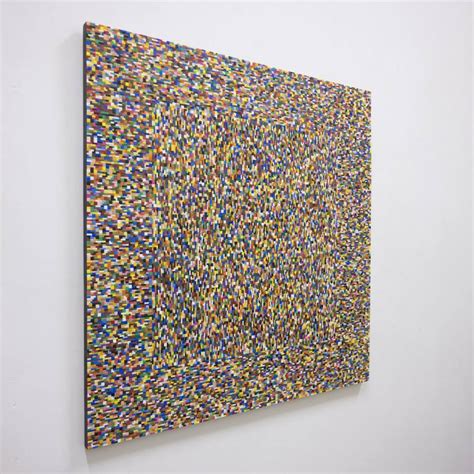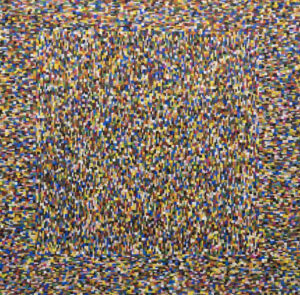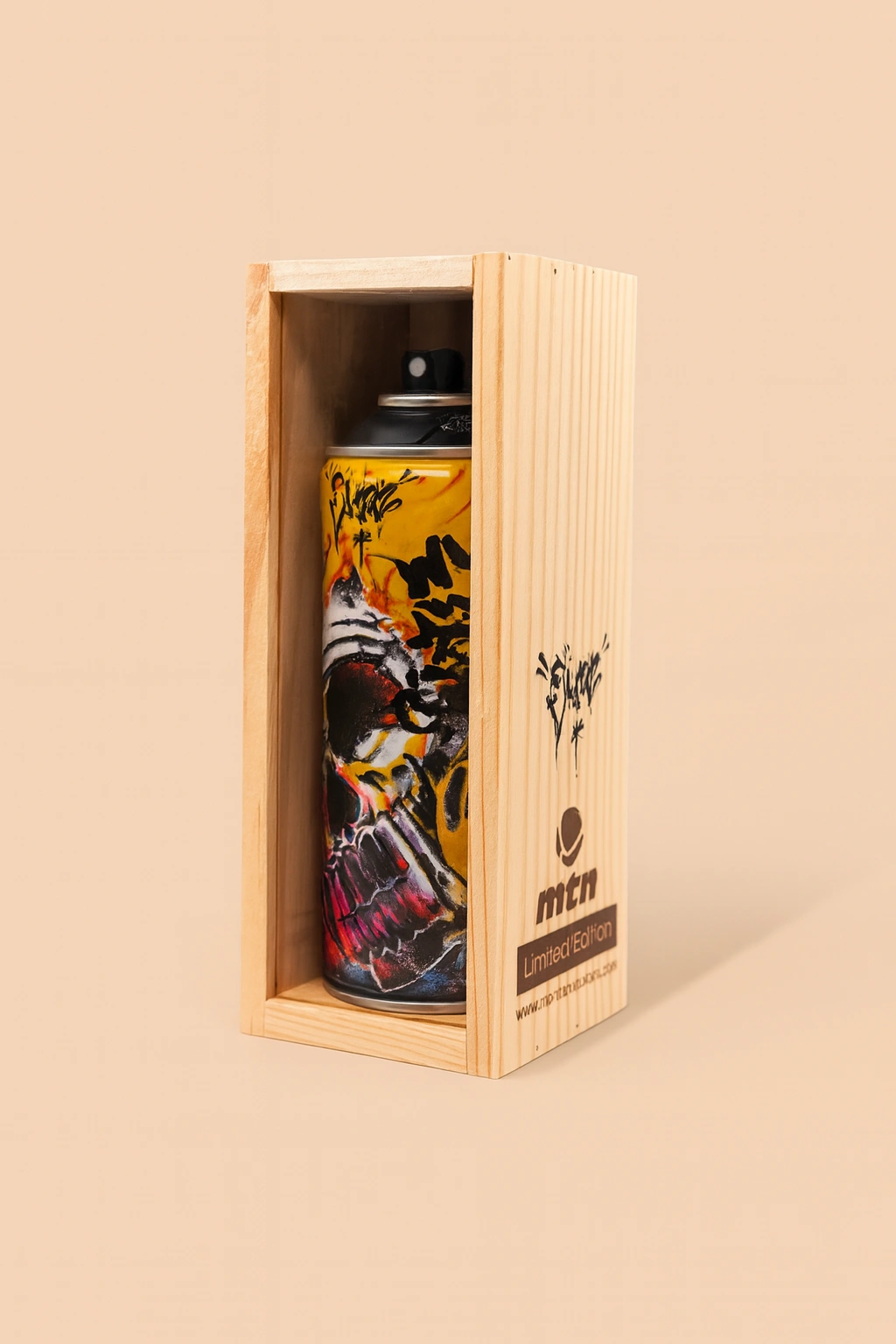Dutch artist Nico Kok has built a career around the exploration of geometric forms, particularly the square, and the interplay of materials, patterns, and randomness. His works challenge conventional perceptions of shape, depth, and organization, often blending conceptual rigor with playful experimentation.
One of his most intriguing projects is the “Pointillist Square,” an artwork that blurs the line between randomness and intention while utilizing a strikingly unconventional medium: Ministeck pieces. Through a carefully controlled process of arrangement, Kok transforms a children’s toy into an immersive study of order, directionality, and visual perception.
Who is Nico Kok?
Born in 1954 in the Netherlands, Nico Kok developed a passion for material exploration, geometric composition, and conceptual art. His education at the Gerrit Rietveld Academy (one of the most influential art institutions in the Netherlands) laid the foundation for his lifelong fascination with sculptural forms and minimalist abstraction.
Throughout his career, Kok’s work has been exhibited across the Netherlands and internationally, with pieces acquired by private collectors, businesses, and government institutions. His approach is marked by a meticulous attention to the properties of materials, often finding beauty and meaning in unexpected objects.
Discovering Ministeck as an Artistic Medium
The idea for the Pointillist Square emerged during the pandemic, when Kok began collecting used construction toys from second-hand stores and online marketplaces. Among the items he gathered was Ministeck, a mosaic-based toy system that allows users to assemble pixelated images using small plastic pieces.
What drew Kok to Ministeck was its potential for structured randomness. While the individual pieces are static, their color, arrangement, and orientation can create dynamic patterns—a concept that parallels pointillism, the painting technique pioneered by Georges Seurat and Paul Signac, where images emerge from tiny, distinct dots of color.
Deconstructing the Pointillist Square
Composition and Structure
Kok’s Pointillist Square is a large, 39.4-inch square panel composed of approximately 23,000 Ministeck pieces. These tiny elements, originally intended for hobbyists and children, are meticulously arranged to create a visually striking effect.
What makes this piece so compelling is that:
The colors of the Ministeck pieces were selected randomly.
Two of the five available Ministeck shapes were deliberately oriented in specific directions.
This directional variation subtly forms a square within the square—without using color differentiation.
The result is a perceptual trick: from a distance, the viewer sees a cohesive square composition, but up close, it dissolves into a sea of individual, structured components.
The Role of Pointillism in the Work
While pointillism in traditional painting relies on color theory and optical mixing, Kok’s Pointillist Square uses directionality and structure to create a similar visual effect.
•In Seurat’s paintings, individual dots of color merge into a recognizable image when viewed from afar.
•In Kok’s Pointillist Square, the oriented Ministeck pieces create subtle patterns that only become visible through sustained observation.
This interplay between order and randomness, macro and micro perception, is central to Kok’s philosophy.
Thematic Significance in Kok’s Work
The Square as an Enduring Motif
Kok’s obsession with the square goes beyond just this one work—it is a recurring motif in his artistic practice. The square, as a geometric form, represents:
Stability and balance – Its four equal sides symbolize uniformity.
Minimalism and purity – Many modernist artists, such as Piet Mondrian, used the square to strip art down to its essential elements.
Order within chaos – While squares appear rigid, Kok’s works show that they can be filled with movement and variation.
Material Transformation: Finding Art in the Everyday
Another defining feature of Kok’s work is his ability to elevate ordinary materials into conceptual art. His use of Ministeck, a mass-produced toy, underscores several key themes:
Recontextualization – By using a children’s craft material in a fine art setting, Kok blurs the boundaries between play and high art.
Material Properties – The plastic pieces’ glossy surfaces catch light differently depending on their orientation, creating a subtle interplay of texture.
Sustainability and Repurposing – The use of second-hand materials reflects a growing trend in contemporary art toward recycling and reinterpreting waste.
Expanding the Concept: The Seven Pointillist Squares
Following the Pointillist Square, Kok took the concept further with his “Seven Pointillist Squares” series.
This variation:
Comprises seven individual squares within a larger composition.
Maintains the randomness of color but varies the directional orientation of the Ministeck pieces in each square.
Creates subtle, internal differentiation between each square despite their shared structural logic.
This series continues to push the boundaries of how simple geometric shapes can generate complexity, reinforcing Kok’s interest in how small changes in structure affect overall perception.
How the Pointillist Square Fits into Contemporary Art Trends
Kok’s work resonates with several broader art movements and trends:
Optical and Kinetic Art
Like artists such as Bridget Riley and Victor Vasarely, Kok plays with visual perception, making static works feel dynamic through subtle shifts in pattern and structure.
Conceptual Art and Found Objects
Kok’s repurposing of Ministeck aligns with the Duchampian tradition of recontextualizing everyday objects, much like how Marcel Duchamp turned a urinal into “Fountain”.
Digital Aesthetics in Physical Form
The pixel-like nature of the Ministeck pieces mimics digital pixels, making Kok’s work a bridge between traditional physical craftsmanship and digital aesthetics.
A Study in Perception and Structure
Nico Kok’s Pointillist Square is more than just an abstract geometric work—it is a conceptual exploration of materiality, perception, and structure. Through his meticulous arrangement of Ministeck pieces, he creates an artwork that engages the eye, challenges expectations, and redefines the possibilities of found materials.
By playing with the tension between randomness and control, Kok encourages viewers to reconsider how simple forms and unexpected materials can come together to create something profoundly thought-provoking and visually dynamic.
His continued explorations with the square and directionality ensure that his work remains at the cutting edge of contemporary conceptual art, making Nico Kok an artist whose work deserves deeper study and appreciation.
No comments yet.









